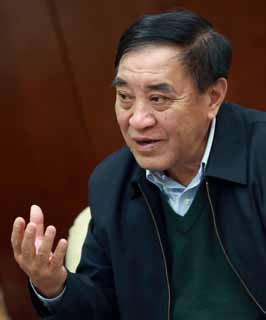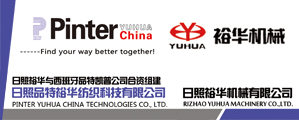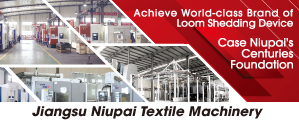Performance quality counts more in moderating economic growth
Jan 15, 2016 | by
Performance quality counts more in moderating economic growth
— On the development of China’s textile industry during the 12th Five-Year Program period by Wang Tiankai, President of CNTAC
Original by Gao Huabin, Niu Fang, Translated by Zhao Zihan
During the 12th Five-Year Program period, China’s textile industry presented various new features in its development. Entering the “New Normal”, the industry development witnessed a moderated speed shift from high to medium. Especially, China’s total export value of textile and apparel showed a negative growth in 2015, which has been the third time following the Asian financial crisis and the global financial crisis under the combined effect of slow global economic recovery as well as changes in exchange rates, decline in the quality of domestic cotton, growing overall costs and many other factors. Will these changes affect the completion of the stated objectives of the 12th Five-Year Program? What are the main achievements of textile and apparel industry during the 12th Five-Year Program period? What are the problems to be solved in the development?
To find answers to the questions, the reporters of China Textile had an interview with Wang Tiankai, President of China National Textile & Apparel Council (CNTAC).

Wang Tiankai, President of China National Textile & Apparel Council
The industry is running smoothly under the new normal
China Textile: What are the main features that China’s textile industry presented during the 12th Five-Year Program period?
Wang Tiankai: Looking back to the development of the “12th Five-Year Program”, the most important change in China’s textile industry is the development of the industry into the new normal, which is characterized by increasing development pressures, growing motive force of growth, continued in-depth adjustment, and basically stable operation. Specifically, the gradual moderation of industry growth from high-and-medium speed to the medium speed resulted in the falling of the majority of economic indicators to single digits from double digits, followed by significant downward trend and pressures. Meanwhile, the structural adjustment, quality enhancement, and the innovation-driven force have played a further supporting role in the industry. An international development trend of establishing a cross-border industrial chain has emerged, reflecting the industry’s ability to adapt to the new normal that the industry has remained a stable, healthy and sustainable development in the transformation and upgrading.
China Textile: Could you please talk about the main achievements that the textile industry has made during the 12th Five-Year Program period?
Wang Tiankai: During the 12th Five-Year Program period, under the guidance of a series of policies and principles of the Party and the State, China’s textile industry has continued to promote structural adjustment and industrial upgrading, witnessing sound achievements in the aspects of economic performance, restructuring, scientific and technological progress, brand building, and ecological civilization.
The first goes to the steady growth of Scale Economies Effect. During the 12th Five-Year Program period, the above-designated textile enterprises saw an average annual growth of around 9% respectively in the industrial added value and main business income, and the total profit is expected to present an average annual growth of 12.0%. The main economic indicators are fairly good in the national industrial system.
In 2015, the national textile and apparel exports were projected at 292 billion USD, an average annual increase of 6.6% during the 12th Five-Year Program period, still a slightly gap between the planning objective of 300 billion USD. The export value accounted for the world rose from 34.1% in 2010 to 37.4% in 2014, an increase of 3.3 percentage points.
The second is the remarkable success of structural adjustment. Since the beginning of the 12th Five-Year Program, the industrial structure has been further optimized. Technical textiles are further playing its role as a new growth point, while the garment, home textiles and technical textiles fiber processing volume saw a change in the proportion from 51:29:20 in 2010 to 46.8:28.6:24.6, in which technical textiles fiber processing volume showed an average annual increase of 10.6%. The proportion of chemical fiber processing volume among the national total grew by 12 percentage points, while the chemical fiber output among the world total increased by 7.7 percentage points. Moreover, China’s textile industry is continuously encouraged to transform to the West and Middle part of the country, where the main business income of above-designated enterprises among the total of the whole industry rose to 22.2% during January – September, 2015 from 16.8% in 2010, among which, Xinjiang is the new hot spot for investment. In addition, textile enterprises have further accelerated their pace to go global, for example, the backbone enterprises have speeded up investment in the construction of manufacturing base in the neighboring countries, gradually beginning to develop towards the high-end fields of the industrial chain in developed countries.
The innovation-driven effects found expression in the 12th Five-Year Program period. Scientific and technological innovation capacity has increased significantly; a number of key technologies of the industry have made progresses with further promotion; digital and network technologies have been widely used in various sectors of the industrial chain; companies have been attaching importance to increasing investment in science and technologies and achieved results; 17 achievements of the whole industry won the National Science and Technology Award, of which “cheese digital automatic dyeing complete sets of technology and equipment” won the First Prize, 650 achievements were awarded the Science and Technology Award by China National Textile and Apparel Council, and the effective patent number from the above-designated enterprises was 3.4 times of the end of the 11th Five-Year Program. Effective promotion of brand building contributed to a substantial increase in brand awareness, and the whole industrial chain brand system is taking shape while an industry brand development management system and brand value evaluation system have been initially established. The fast-growing textile and apparel e-commerce have expanded the market influence of brand products.
Overall, during the 12th Five-Year Program period, the scientific and technological progress of the industry was mainly reflected in key technologies, materials, equipment, etc. China’s textile equipment manufacturing industry is enjoying a continuous influence globally, and new chemical fiber materials have made a breakthrough.
Last but not the least, there is progress in green development. During the 12th Five-Year Program period, a large number of energy-saving and emission-reduction technologies have been widely promoted and applied in such sectors as cotton, chemical fiber, and dyeing & printing. Water used by 100-meter cloth was cut down to less than 1.8 tons from the original 2.5 toms, while water reuse rate saw an increase from 15% to over 30%. Recycling fiber production reached six million tons, the proportion of which among the total fiber processing volume rose to more than 12% from 9.6% in 2010. “Zero Discard of Old Clothes” activities have exerted a broad impact on society, promoting the recycling and sorting of textile waste as well as the comprehensive utilization of construction and development of industrial chain.
Facts struck back “collapse” argument
China Textile: During the 12th Five-Year Program period, what are the bottlenecks and highlighting problems to be solved in the development of the industry?
Wang Tiankai: Since the beginning of the 12th Five-Year Program, the textile industry has made some achievements, but there are a lot of problems and issues that have harassed development of the industry, including: domestic and international cotton price difference is still larger together with decline in the quality of domestic cotton, and the super-thousand tons of the State Reserve cotton and imported cotton quota control system have hindered the cotton market reform process; some industries are still suffering structural surplus capacity with low capacity utilization, high product inventory, and cash flow difficulties; labor costs continue to rise, and the per capita wage in the textile industry is 2 to 3 times of Vietnam, and more than 5 times of Bangladesh; scattered scientific and technological resources have not yet formed into integrated innovation capability because of the relative lack of R&D investment and innovative talents; textile enterprises are facing technical, managerial and funding pressures to meet the increasingly stringent environmental governance requirements.
China Textile: 2015 is the end of the 12th Five-Year Program period, which is likely to witness a negative growth of textile exports for the first time after a high growth for many years. How do you see this problem? How do you estimate the economic performance in 2015?
Wang Tiankai: During the 12th Five-Year Program period, subject to the subsequent impact of the international financial crisis, the world economy and trade growth saw a slow recovery in 2015, causing a very grim export situation of the industry. Although the industry as a whole is running relatively stable, together with normal performance of the industrial added value, the main business revenue, profit and investment growth, the industry exports are suffering a continued negative growth, which may be temporarily unable to be reversed. From January to October in 2015, textile and apparel exports fell by 5.4% year on year in total value, 2.5 percentage points larger declining over the first half of 2015, both in volume and value. It is the third time that exports have showed a negative growth since the Asian financial crisis and the global financial crisis under the combined effect of slow global economic recovery as well as changes in exchange rates, decline in the quality of domestic cotton, growing overall costs and many other factors. In addition to the above factors, the textile and garment exports in the future will be affected by global and regional trade liberalization; however, if the industry can give full play to the advantages of the industrial chain and accelerate structural adjustment, to achieve the goal of maintaining moderate growth in exports is still of much more probability .
The economic performance of the industry in 2015 would still remain basically stable, and it is expected that the above-designated enterprises will see a year-on-year increase of 6.5% in terms of industrial added value, about 5% in the main business income, around 8% in total profits; however, a negative growth in exports is basically a foregone conclusion, which is predicted to fall by about 5% year on year.
China Textile: Currently, the industry growth has slowed down, and some economists and foreign research institutions began bad-mouthing Chinese textiles. How do you view this issue?
Wang Tiankai: At present, China’s textile industry is at an adjustment phase in the transformation and upgrading, therefore, somewhat slow industry growth rate does not matter. With so huge an industrial scale as well as so massive a total output, there is no necessity for China’s textile industry to maintain a double-digit growth. At present, we should look more to the quality of economic operation of the industry.
Upgrading is a process to improve the allocation of resources together with corporate survival of the fittest. It is a dynamic process. Currently, many economists or foreign institutions are making static analysis of China’s textile industry, reaching such pessimistic conclusions as lack of the industry development potential in the future. We believe that the analysis is unscientific only based on the static theory since China’s economic development is a dynamic process. When ten years ago, the appreciation of yuan was in the initial stage, the results from economists and enterprises estimated that, if renminbi saw an appreciation of 5%, the whole industry would suffer losses, and the textile industry would face the risk of bankruptcy. However, how much has renminbi appreciated? Have we gone out yet?
At that time when we entered the WTO, a lot of companies claimed that, in accordance with WTO rules, the textile industry would face the risk of “bankruptcy”; on the contrary, we are enjoying a better development instead of going bankrupt. There is still plenty of leeway in Chinese economy, and to get rid of the industry’s current development difficulties, much more efforts are required in such dynamic aspects as reform and innovation.
As it can be seen from the history of Chinese textile development, no matter how difficult the development of the industry is, shinning is still there as long as the sun rises, even if only a little while. We believe that a group of outstanding entrepreneurs are to grow up during the transformation and upgrading, and after survival of the fittest, the whole textile industry will be full of fresh life.








